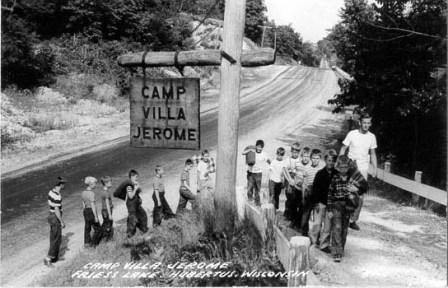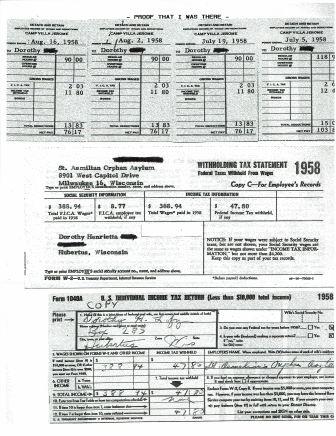Camp Villa Jerome - Part 1
Memories of Camp Villa Jerome by Dorothy who worked at the Camp in the 1950s
In 1932 St. Aemilian’s Orphange of Milwaukee purchased land from a farmer to create Camp Villa Jerome in the Township of Richfield. It was 140 acres with 1,200 feet of lake frontage on Friess Lake. The entrance to the  camp was on Hwy. 167. The driveway still remains but is closed due to the entrance now being on Friess Lake Rd. which leads to the Glacier Hills County Park.
camp was on Hwy. 167. The driveway still remains but is closed due to the entrance now being on Friess Lake Rd. which leads to the Glacier Hills County Park.
For eight weeks every summer, approximately 50 young boys from St. Aemilian’s Orphange were brought to the camp. In addition to the orphans, families from Milwaukee, Racine, Chicago, etc. enrolled their sons for the two-week periods. The 24 counselors were young men from Catholic high schools and colleges from Milwaukee, Racine, Illinois, Menomonee Falls, etc. Counting the orphans, campers and counselors, the total was 120. The overseer of the camp was Ray Sonnenberg, the Priest was Father Bloedorn from St. Aemilians and the caretakers were Mr. and Mrs. Cornelius Friess (Corny and Tessie). There were cute little houses that overlooked Friess Lake where they resided.
 The camp grounds consisted of the mess hall, a horse barn, the infirmary, a taxidermy building, the chapel and the cabins. Also, there were a few old railroad cars adjacent to the grounds where some of the counselors stayed. The classes taught were horseback riding, woodworking, swimming, canoeing, archery, etc. The evening entertainment was story telling by the campfire, volleyball and baseball. The class periods throughout the day began and ended with the sound of a bull horn.
The camp grounds consisted of the mess hall, a horse barn, the infirmary, a taxidermy building, the chapel and the cabins. Also, there were a few old railroad cars adjacent to the grounds where some of the counselors stayed. The classes taught were horseback riding, woodworking, swimming, canoeing, archery, etc. The evening entertainment was story telling by the campfire, volleyball and baseball. The class periods throughout the day began and ended with the sound of a bull horn.
In the late 1940s and early 1950s, Rosella Friess and her daughters, Betty and Adell, worked in the kitchen and mess hall. Adell remembers clearing and washing the tables after every meal and washing the floor every week. Other chores included helping in the kitchen. The dishes were washed in 212-degree water and, of course, were very hot when removed. The potatoes were put into a cylindrical appliance that vibrated and therefore, removed the skins. In those years there were about 10 nuns who were part of the teaching staff. They also assisted in the infirmary and cooked for Father Bloedorn. Adell remembers that the Pledge of Allegiance was recited every morning.
In the summer of 1958, my 16-year-old brother, Jim, and I (age 17) worked  there. Jim worked in the horse barn and I in the mess hall. The horse barn housed 12 horses which were rented from a stable in Fond du Lac. Ten horses were used for each riding class. One was a Tennessee Walker and another was a golden palomino. William Campbell trained Jim to be a riding instructor. They named the horses Peggy Sue, Moses, Diablo and so on. Every morning began with cleaning the pend sneaking sugar cubes to them for a treat. The chores included wans, putting down new straw, feeding the horses ashing the horses. They had an old converted Omar Bakery truck to haul the manure to a pasture. The Diablo was a chestnut mare which took a bite of Jim’s arm which required him to visit the infirmary. Moses was famous for lifting the latch and letting the other horses out of the pen. During their break times, the fellas played poker. One day our mother was ironing and discovered one of Jim’s nice shirts was missing. Guess what! He lost it in a poker game.
there. Jim worked in the horse barn and I in the mess hall. The horse barn housed 12 horses which were rented from a stable in Fond du Lac. Ten horses were used for each riding class. One was a Tennessee Walker and another was a golden palomino. William Campbell trained Jim to be a riding instructor. They named the horses Peggy Sue, Moses, Diablo and so on. Every morning began with cleaning the pend sneaking sugar cubes to them for a treat. The chores included wans, putting down new straw, feeding the horses ashing the horses. They had an old converted Omar Bakery truck to haul the manure to a pasture. The Diablo was a chestnut mare which took a bite of Jim’s arm which required him to visit the infirmary. Moses was famous for lifting the latch and letting the other horses out of the pen. During their break times, the fellas played poker. One day our mother was ironing and discovered one of Jim’s nice shirts was missing. Guess what! He lost it in a poker game.
Photos: Entrance to Camp Villa Jerome; Camp Villa Jerome Cottages; Dorothy’s Wage Record
Enjoy our other stories

